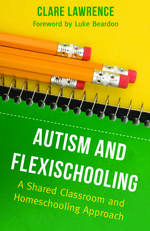 Clare Lawrence is a teacher, autism worker and mother of two children, one of whom has Asperger syndrome (AS). She works closely with schools across the UK, exploring practical solutions for how to make education more accessible for children with AS. Here, she discusses her new book, Autism and Flexischooling: A Shared Classroom and Homeschooling Approach.
Clare Lawrence is a teacher, autism worker and mother of two children, one of whom has Asperger syndrome (AS). She works closely with schools across the UK, exploring practical solutions for how to make education more accessible for children with AS. Here, she discusses her new book, Autism and Flexischooling: A Shared Classroom and Homeschooling Approach.
Can you tell us what flexischooling is, and what inspired you to write this new guide about it?
Flexischooling is when parents and school share the responsibility for a child’s education. Of course, this means that all children flexischool to a certain extent, but it is taken to mean that the child’s education time is shared out between home and school. Perhaps the pupil will go into school for mornings, and be educated at home in the afternoons, or perhaps he or she will go into school for some lessons but cover other subjects at home. There are so many ways of approaching it, depending on what works best for child, school or parents.
It is a very flexible arrangement and one which, at its best, can mean that the child is literally getting the ‘best of both worlds’. We have been flexischooling with our younger child for the last eight years, and it has always worked extremely well for us and, I think, for the schools involved.
Very few people are aware of the option to flexischool. Although parents do not have an automatic ‘right’ to it as an approach, if they and the school agree that it is best for the child it is a perfectly legal option. There is very little literature available to help parents or school understand either the strengths or the potential pitfalls of the option, and so this book hopes to put that right.
Why is flexischooling a particularly effective approach for educating children with autism?
The whole issue of school can be a tremendous challenge for children with autism and Asperger syndrome. It is a demanding, noisy, social environment, and many children with an Autism Spectrum Difference (ASD) find it very challenging indeed. Many adults with an ASD will say how unhappy they were at school, citing bullying and social exclusion, feeling overwhelmed, anxious or even frightened for much of the time and that they never felt they managed to ‘fit in’ or to reach their potential. Curiously, in spite of this experience the same adults will also frequently regret the passing of the school years, in that school gave a clear and concrete structure and an opportunity for academic learning. Life after school has ended, especially for those who find themselves without work, can be alarmingly lacking in both structure and interesting content.
School, then, can offer a great deal to pupils with autism, but it also presents them with daunting challenges. Flexischooling can take the pressure off the ‘in-school’ component by keeping sessions in school shorter and more manageable. There is time in a flexischooling timetable for the child to recover, to go back over what was said or what happened in school, and to find ways to understand. There is the opportunity for the student to access expertise and teaching and also time to explore and develop his or her own strengths and interests and to use the focus that an ASD so often brings to advantage. It also gives both time and structure for interaction between child and parents. Attendance at school may be part-time under a flexischooling arrangement but education remains most definitely full-time, and this formal learning time can be a tremendous opportunity for parents to continue to work closely with their child with autism. Flexischooling allows school, parents and child to work together, as a team. In so many ways it is a thoroughly ‘autism friendly’ approach, and is one recommended by many autism experts.
What are some common obstacles that parents might encounter when trying to negotiate flexischooling with their child’s school? How can this book help?
Because it is an approach that is still quite rarely explored, many schools will not have experienced flexischooling before. It can take some time for the school to really appreciate what is being suggested, and this book should help to make that process more accessible for all. The book is not ‘anti-school’, and throughout it stresses that flexischooling is a partnership, one that hopes to benefit all the parties – the school and the parents, the teachers and the other students as well as most importantly the child himself.
What do you hope parents will take away from this book?
I hope that parents will take from the book that there is this ‘other’ option. For many children with an ASD the dedication of teachers and support staff will mean that full time school is a success. For others, their parents will prefer to withdraw them from the system completely and educate them at home. Both of these options are perfectly valid, and flexischooling is not designed to replace either. Rather, it is simply another choice to consider. When the best of school and the best of home can be combined in this way, and the expertise of parents and teacher shared, I believe that it is a choice that is very well worth considering.
Copyright © Jessica Kingsley Publishers 2012.